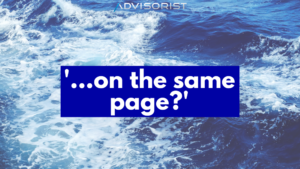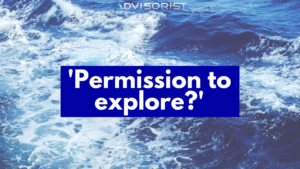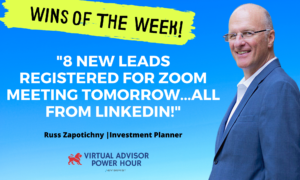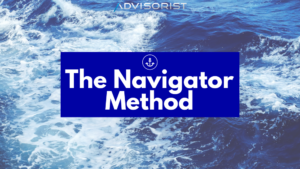
Can we be frank?
For decades, our industry has been characterized by product pushers.
And for years, many product-pushing advisors have done well for themselves.
But we’re reaching a point in this industry where finding warm bodies and then pushing a specific product on them is no longer effective (or necessarily ethical).
With the amount of choices and information that exist in the insurance and financial services industry – including the likes of robo-advisors – a product-first sales strategy is no longer the optimum model for building a successful and scalable practice.
Instead, we’re seeing a new type of advisor rise the top: The Navigator.
Today’s Top 1% Advisors are stiff-arming the old strategy of hawking products and replacing it with a method that starts with the prospect and ultimately helps them find the right solutions for their most pressing needs and desires.
It’s a client-centered approach.
And we’re calling it the Navigator Method.
For the insurance or financial advisor who is serious about building a sustainable practice, this approach has the potential to change everything.
The Navigator Method for Virtual Advisors

The Navigator Method is best understood using an analogy. And in this analogy, there are a few moving parts:
- The Boat. The boat represents the average prospect. Sometimes the waters are calm and the boat sails smoothly. Other times there are storms and the boat finds itself dealing with treacherous waters.
- The Shore of Mediocrity. Ultimately, no matter how nice the boat is, it eventually gets pushed up onto the “Shore of Mediocrity.” Sometimes boats get thrown all the way up onto the shore and have no way of getting back into the water. While other times, boats anchor a little ways off the shore and get distracted by the sight of land. As the name suggests, everything on the Shore of Mediocrity is average, but there’s something oddly comforting about it (especially when there are stormy seas). As such, most people gravitate to it.
- Paradise Island. Several miles out in the water there’s a haven that we’ll call “Paradise Island.” This beautiful and peaceful island is where every prospect truly wants to be (even if they don’t know it just yet).
- The Navigator. You are the Navigator (or at least you’ll be prepared to be a Navigator once you’re done reading this article). It’s your job to find boats that are washed up on the Shore of Mediocrity and get permission to guide them to Paradise Island. In fact, that’s your highest and best calling.
At first glance, you might assume that navigating a prospect from the Shore of Mediocrity to Paradise Island is as easy as finding a prospect, jumping in their boat, and setting sail.
But in reality, it’s much more nuanced than this.
Your biggest challenge as the Navigator is to help people cut through the fog so that they can see Paradise Island.
Every prospect deals with fog whether they realize it or not. This fog can show up in a variety of ways (when you get into fact finding) and prevents them from getting to Paradise Island.
Common sources of fog include:
- Choices (Term life vs. whole life)
- Discomfort (Death, disease, or disability)
- Dissolution (That won’t happen to me…)
- Uncertainty
- Disagreement between spouses
- Other advisors/competition
- Overwhelm (the goal is too big)
- Pride
- Cost
- Disbelief (looks too good to be true)
The only way to successfully and ethically move a prospect to Paradise Island (where your products/solutions await) is to dig in.
Effective Tie Downs That Silently Give You Permission to Dig In
Many insurance and financial advisors unwittingly believe that landing a sales call or virtual meeting with a prospect means they’re “in.”
But truth be told, getting a prospect to agree to a call is only the very first step. To use another analogy, it’s like knocking on a door and having someone open it.
The next step requires you to get your foot in the door so that the prospect doesn’t slam it shut.
And here are a couple of techniques you can use to silently give you the permission to come “inside,” where you can ask more meaningful questions that ultimately help you become their Navigator:
Tie downs are effective tools for doing this.
(A tie down is basically what you use to get confirmation and approval to continue. It allows the prospect to stop moving backward in the conversation. You get them to commit and verbally agree to what they just said.)
Here are a few good tie-downs that work well in the Navigator Method:

1. The ‘Why-Are-We-Here?’ Question
After some initial small talk, try your best to naturally segue into the following question:
“May I ask what it is that made you invest the time to have this call today?”
While you’ll occasionally get a prospect who offers a vague reply, most will be quite transparent with you. And though they won’t always give you the exact answer you’re hoping for, you’ll at least know where they stand.
After the prospect gives you their answer, you can follow up by laying out the blueprint for the rest of the call.
For example:
Okay, very good. Well, I’m glad we get the chance to talk today.
This call will be a 30-minute call. At the end of the call, we’ll decide if it makes sense for us to move forward or not. Typically – if we both agree – then the next step will involve setting up a second call. But I’m not even going to talk about that right now, because I really want to know if we’re the right fit. Sound good?
That’s it.
Tie down number one is complete. (And you haven’t even broken a sweat!)

2. The ‘On-the-Same-Page’ Question
You want to make it very clear from the start that you aren’t another product-hawking advisor, but a guide.
The following question sets you up as their Navigator and gets them to make a small and unassuming commitment:
“My goal here today is to completely serve you, Mary. It could be that by the end of this call we decide not to do business together. (Because I don’t know if or how I can help.) Or I’ll refer you to someone else who I think can be a good fit. Does that make sense to you?”
By saying this, you make it clear that you aren’t a pushy salesperson.
It reduces the pressure and stresses that they have to act. (It also gives them an out, which makes them more likely to engage with you.)

3. The ‘Permission-to-Explore’ Question
Once you feel like you’re on the same page and the prospect knows what to expect, you have to get permission to dig in deeper than surface level.
Here’s one way to do this:
So, Mary…here’s how the call is going to go…
I’m just going to ask you some questions about your finances, your goals, your life insurance, and [insert appropriate topics]. I want to see if we’re the right fit for each other.
Like I said before, it’ll be about 30 minutes long.
Nothing I ask is because I’m trying to be nosey….I’m really just trying to see if there’s a good fit here. If there is, great! If there’s not, that’s fine too.
The more open you are with me, the more you’re going to get out of the call.
Does that sound good?
In 99% of sales calls, the prospect will agree. And just like that you’ve already earned permission to ask them tough questions. This includes questions about sensitive and awkward topics like money, health, and relationships.
And since you have their permission, you might as well throw them some fastballs like:
- What’s your annual income?
- How much do you have in savings?
- How much debt do you have today?
You should also get clear on whether they’re navigating alone or working with someone else by asking questions like:
- What have you done to solve this issue so far?
- What have you tried in the past?
- Who have you been working with so far?
No Pain, No Sale
The entire goal of the Navigator Method is to widen the gap between the Shore and the Island.
You’re helping them see how far they are from Paradise Island – even after all of the work and effort they’ve put in over the years.
You aren’t selling a product (initially) – you’re making them see the reality of their pain.
People on the Shore of Mediocrity are stuck in latent pain (and have been for most of their lives). Before you can show them what solutions exist, you have to help them feel the pain.
If you don’t follow the Navigator Method, you’re going to leave people in this latent pain.
You want to move them into the active pain stage, SO THAT you can help them win.
Let the people live in this active pain stage for a time! There will be a time when you pull them out, but now is not the time.
Take a Deeper Dive Into Prospecting, Sales, and Marketing for Insurance and Financial Advisors
Yesterday’s strategies no longer work in this space.
If you want to learn more about prospecting, sales, and marketing for virtual advisors in today’s rapidly evolving marketplace, the Virtual Advisor Power Hour is where you need to be.
Every single Wednesday, thousands of insurance and financial advisors show up LIVE for the industry’s top masterclass – a 60-minute rapid-fire knowledge session where we share what’s working TODAY.
>> If you’d like to join us, simply reserve a seat and add the VAPH to your calendar <<
Check out some of the wins VAPH attendees have already celebrated this year! ⬇️







